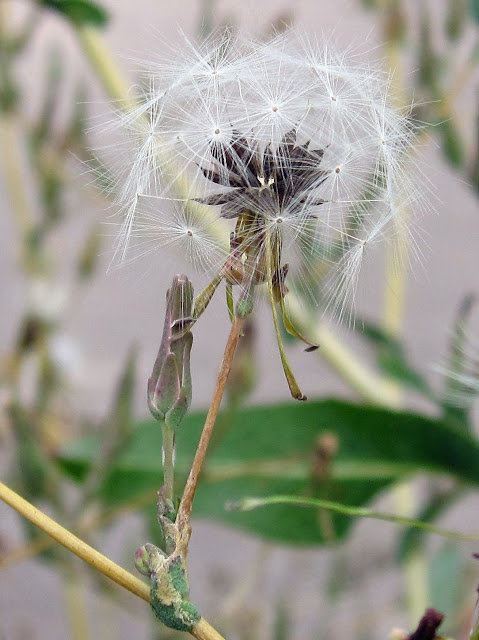 |
| Prickly Lettuce, Lactuca seriola. Scadbury Park, 11 September 2011. |
This one, Prickly Lettuce, grows as a single stem. At first, it just has those alternating leaves, plain and green, and then quite quickly it sprouts a many-branched flower-head.
The flowers are composite, and like many other wildflowers, they look a little like dandelions. Individually they are short-lived and do not stay open all day, so you might not find it easy to see them unless you keep watch. You can see that although this plant is fully mature, there are no visible flowers. This shot was taken early in the afternoon.
Below is a photo taken in mid-morning, a flower with a hoverfly taking advantage of it. That is a Marmalade Hoverfly, Episyrphus balteatus, one of the commonest and prettiest of the British hoverflies.
Under that is a shot of the seedhead, and you can see that this, too, is on the same general plan as a dandelion, though the individual parachutes and seeds are larger.
And finally, in case you are wondering why it should be called "prickly," there is a closeup of the underside of a leaf. Even though the prickles are not very strong, this is still not something you would welcome in a plate of salad.
The seed head and the whole plant were taken with my Ixus 100; the leaf and the flower with my EOS 60D and 100mm macro lens.
 |
| Marmalade hoverfly, Episyrphus balteatus, on a flower of Prickly Lettuce, Lactuca serriola, at the edge of Hayes Station car park, 26 July 2011. |
 |
| Prickly Lettuce, Lactuca serriola. Seed heads by Hayes Station car park. 12 August 2011. |
 |
| Prickly Lettuce, Lactuca serriola. Underside of a leaf. Scadbury Park, 11 September 2011. |
Lovely stuff, glorious photos. I always thought the the four-letter word for non-invasive plants integral to the ecology of a place is WEED. Weeds don't look like plastic as, admittedly, my spider lily (cultivated on three continents where it grows) does. But glorious photos, such as take real seeing as well as good equipment.
ReplyDelete